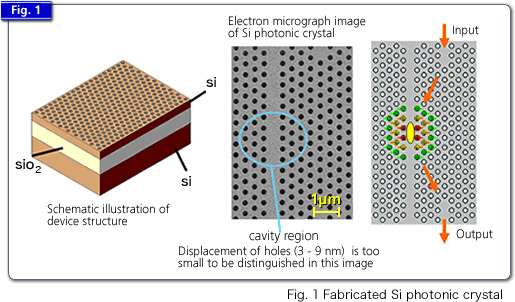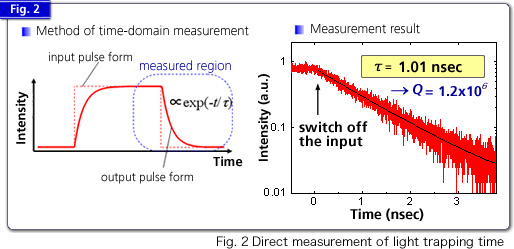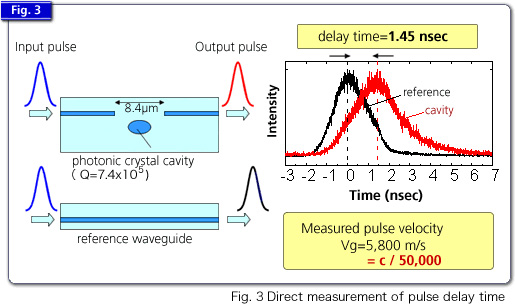Trapping and Delaying Light for Over One Nanosecond Using Photonic Crystals
- Slowing down light to one 50 thousandth of its speed in air-

NTT Basic Research Laboratories have succeeded in trapping light for over one nanosecond inside a wavelength-sized micro-cavity based on an artificial periodic structure called a "photonic crystal." The micro-cavity is capable of delaying transmitted light by more than one nanosecond, which implies that the speed of light is reduced down to one 50 thousandth of that in the air.
It has long been believed that trapping or delaying light is of fundamental difficulty. NTT has overcome this difficulty by employing a novel design for the photonic-crystal-based resonator and by developing state-of-the-art nano-fabrication technology to realize the designed structure. These achievements will open up many possibilities for photonics including a large-scale photonic information-processing chip that requires extremely low power and an optical quantum-information processor that can be operated with single photons. These results will be published online in "Nature Photonics" on December 22nd.
=> Press Release
=> Photonic Nano-Structure Research Group

Fig. 1 Fabricated Si photonic crystal
Our device is based on a photonic crystal that comprises an array of air holes, 100 nanometers in radius, arranged in a hexagonal lattice, fabricated on a silicon chip by state-of-the-art nano-processing technology. The ultra-small optical cavity consists of a single line of missing air holes defined in the matrix of a photonic crystal acting as a photonic insulator. The key design feature is that some of the holes adjacent to the line defect are intentionally displaced outward by three to nine nanometers. This small displacement modulates the width of the line defect, thereby enhancing its ability to confine light.

Fig. 2 Direct measurement of light trapping time
Temporal decay of light output after abruptly switching off the input, observed in a direct time-domain measurement, demonstrates that the light is being trapped inside the cavity for over one nanosecond. The measured decay time of 1.01 nanoseconds corresponds to a cavity quality factor (Q-value) of 1.2 million, the largest value ever reported for any wavelength-sized optical cavity.

Fig. 3 Direct measurement of pulse delay time
Pulse measurements show that the transmitted pulse is delayed for 1.45 nanoseconds by the cavity. This corresponds to the traveling speed of light being reduced down to one 50 thousandth of that in air. The trapping and delaying times achieved here are longer than those for any wavelength-sized dielectric media, and the factor of 50 is more than two orders of magnitude larger than that reported for any media.










